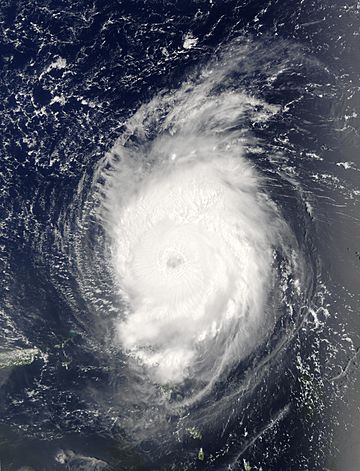Hurricane Fabian facts for kids
| Category 4 major hurricane (SSHWS/NWS) | |

Hurricane Fabian near the Leeward Islands.
|
|
| Formed | August 25, 2003 |
|---|---|
| Dissipated | September 8, 2003 |
| Highest winds | 1-minute sustained: 145 mph (230 km/h) |
| Lowest pressure | 939 mbar (hPa); 27.73 inHg |
| Damage | $300 million (2003 USD) |
| Areas affected | Bermuda, offshore south of Atlantic Canada |
| Part of the 2003 Atlantic hurricane season | |
Hurricane Fabian was a very powerful storm that hit Bermuda in September 2003. It was a type of hurricane called a Cape Verde-type hurricane, which means it started near the Cape Verde islands off the coast of Africa. Fabian was the sixth named storm and the first really big hurricane of the 2003 Atlantic hurricane season.
Contents
Storm's Journey
Fabian started as a tropical wave in the Atlantic Ocean on August 25. A tropical wave is like a ripple in the air that can grow into a storm. It moved towards the west-northwest because of a high-pressure area called a subtropical ridge to its north. The storm grew stronger because the ocean water was warm and there wasn't much wind shear. Wind shear is when winds blow at different speeds or directions at different heights, which can break a storm apart.
Fabian became super strong on September 1, with winds reaching about 145 mph (230 km/h). It then slowly got a bit weaker as it turned north. On September 5, Hurricane Fabian hit the island of Bermuda directly. Its winds were still very strong, over 120 mph (195 km/h). After passing Bermuda, the hurricane moved northeast and changed into a different type of storm called an extratropical cyclone on September 8.
Fabian's Impact and Aftermath
Fabian was the strongest hurricane to hit Bermuda since Hurricane Arlene in 1963. It caused a lot of damage and was the first hurricane to cause deaths on the island since 1926. The hurricane's strong winds ripped off roofs and caused damage all over Bermuda.
A powerful storm surge also hit the island. A storm surge is a rise in sea level caused by a storm's strong winds pushing water towards the shore. This surge caused four people to lose their lives while they were trying to cross a causeway in Bermuda. The causeway is the only road connecting two parts of the island, and it was closed for a while.
The hurricane also put a special bird called the Bermuda Petrel, or Cahow, in danger. Ten of their nests were destroyed. Luckily, volunteers helped move these birds to a safer place. Strong ocean waves from Fabian also caused damage in northern Puerto Rico and the Dominican Republic. Four people also drowned along the United States' Atlantic coast because of these waves. In total, Hurricane Fabian caused about $300 million (in 2003 USD) in damage and led to eight deaths.
Why Fabian's Name Was Retired
Because Hurricane Fabian caused so much damage and led to deaths in Bermuda, its name was taken off the list of hurricane names. This means no future hurricane will ever be called Fabian again. This is done to honor the victims and to avoid confusion with past storms. The name Fred replaced Fabian in 2009.
|
Tropical cyclones of the 2003 Atlantic hurricane season |
|||||||||||||||||||||||||||||||||||||
|
|
||||||||||||||||||||||||||||||||||||
|
|
|||||||||||||||||||||||||||||||||||||
Images for kids
-
Hurricane Fabian south of Bermuda on September 5
-
Damaged terminal at Bermuda International Airport
See also
 In Spanish: Huracán Fabian para niños
In Spanish: Huracán Fabian para niños









